By Taryn Wong Fowler –
The history of Waikiki Beach and surfing cannot be told without mention of the Waikiki beach boys. The “glory days” of the beach boys were during the 1920s to the 1930s on the famous stretch of beach from the Moana Hotel (now known as the Moana Surfrider) to the Royal Hawaiian Hotel . The original beach boys gave the gift of Hawaii to the rest of the world and helped preserve a piece of Hawaiian culture, thus creating what is now today’s surf culture.
Waikiki Beach was the beach boys’ lifelong playground. The beach boys on any given day would be surfing, outrigger canoe paddling, playing music, singing, fishing, coconut climbing, weaving hats, and talking story. They made their livelihood off teaching tourists how to surf and taking them out on outrigger canoes. The original Waikiki beach boys were very unique men mostly Hawaiian or part Hawaiian with equally unique nicknames like Chick, Steamboat, and Rabbit.
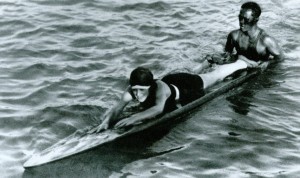
The standard surf lesson assisted by a push from the instructor; the beach boy is also helping to learn balance on the board. The beach boys were true “ambassadors of aloha” and the first lifeguards on Waikiki Beach.
The first Waikiki beach boys resided under two friendly rival beach clubs, the Outrigger Canoe Club and the Hui Nalu, which both had clubhouses at the Moana Hotel. The two clubs comprised of the best watermen in Waikiki, and they even had surfing and outrigger contests between the two. Eventually, the Outrigger Canoe Club became more of a social club, whereas the Hui Nalu began to capitalize on the tourism boom and became more of an organized business.
After the opening of the Royal Hawaiian Hotel in 1927, tourists, especially wealthy celebrity figures such as Nelson Rockefeller, Douglas Fairbanks, Shirley Temple, and Doris Duke, began to visit Waikiki. The beach boys welcomed the visitors, taught them surfing and canoeing, and entertained them. The beach boys’ spirit of aloha, the spirit of “unconditional giving,” and “ocean is life” is at the heart of a true Waikiki beach boy. This persona and lifestyle made a huge impact on the visitors who came to the islands.
Around the mid 1950s, tourism really began to explode in Hawaii and more hotels and businesses began to open. Fast forward to present day, and the beach boys still exist in Waikiki. Tourists that visit this famous strip of sand can still get a surf lesson, an outrigger canoe ride, or catamaran sail from a Waikiki beach boy. Nowadays the new generation of beach boys still cherish the old timers’ spirit and what Duke Kahanamoku represents, the true spirit of Aloha.
Waikiki beach boys you should know…
Duke Paoa Kahanamoku
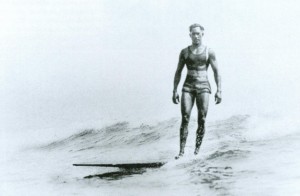
Duke Kahanamoku
“The King of Waikiki Beach” and “the father of modern surfing” was born in 1890 and raised in Waikiki. Duke was a true waterman, surfer, canoe paddler, record breaking swimmer, and the “first truly famous beach boy.” Duke was one of the founders of the beach boy club Hui Nalu and later became Hawaii’s unofficial ambassador. Credited with introducing surfing and Hawaii to the rest of the world, Duke was a world traveler and the first man to surf on both the east and west coasts of the United States and to take surfing to Australia. Throughout Duke’s life he had an Olympic swimming career, was in 28 Hollywood movies, and worked various odd jobs, but always returned to the ocean. In his later years, he and his brand became a iconic figure that will forever embody the true spirit of Aloha.
Duke’s Legacy is carried on today largely by the efforts of the Outrigger Duke Kahanamoku Foundation. The mission of the foundation is to financially support the development of individuals and organizations that perpetuate the spirit and legacy of Duke Kahanamoku by encouraging athletes and scholars whose endeavors will contribute to the growth and development of athletics in Hawaii, supporting athletic events both locally and internationally, educational support, and assisting in preserving, perpetuating and developing sports which have a special cultural and historical significance to Hawaii.
Chick Daniels “The Happiest Hawaiian”
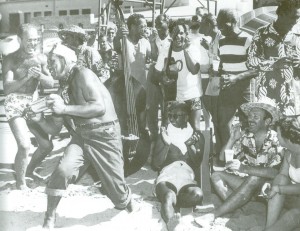
‘The Cocktail Shake’ being performed with musical help from Willie Cohen, Panama Dave, Mystery Cockett, Melvin Paoa, Duke Kahanamoku, Kalakaua Aylett and Jimmy Hakuole. (courtesy Charlie Lambert)
William “Chick” Daniels was born in 1899 to German-Hawaiian parents and raised on the island of Kauai. In his 20’s Chick starting working as a Waikiki beach boy as the head beach attendant at the Royal Hawaiian Hotel and got the nickname from other beach boys after a popular movie detective. Chick was a strong swimmer, surfer, spear fisherman, and entertainer who played the ukulele, danced hula, and sang.
Chick was a hard working beach boy, but is most remembered for his fun and generous spirit, spending lots of money, and years of entertaining. His entertainer career lasted about 40 years long, and he was known for his infamous “pants-dropping act” that was at the climax of his performances. Chick passed away in 1982 and it’s said that no beach boy “was as well loved as Chick Daniels.”
Albert “Rabbit” Kekai
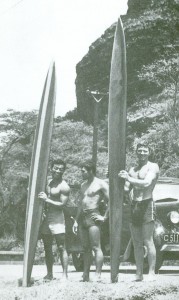
From Left: Russ Takaki, Rabbit Kekai and Wally Froiseth at Makaha Beach in 1949. (courtesy Wally Froiseth)
Born November 11, 1920 and is the only living Waikiki beach boys from the “glory years.” At the age of 10 Rabbit learned about surfing and outrigger canoe paddling from Duke Kahanamoku. Rabbit was a member of the second generation of the Hui Nalu surf club and by age 14 he was one of the club’s best steersmen. In the 1930s, Rabbit was one of the first surfers to start surfing shorter surfboards like paipo boards (wood boards the size of the modern day body board). Rabbit is credited with being one of the first surfers to start “hot-dogging” (ripping, carving, or zigzagging) on face of the wave. At age 15, Rabbit was also the youngest Waikiki beach boy to get his captain’s license.
Rabbit has had countless accomplishments throughout his life and is a champion surfer and canoe man. He is one of the founders of the Waikiki Surf Club and in 2002 started the Keiki Surfing Contest. Most recently, the Rabbit Kekai Foundation was founded “to perpetuate the lifestyle of the Waikiki beach boys and educate Hawaii’s youth in Hawaiian Charter Schools.” Rabbit Kekai is a true Hawaiian living legend.
Want to Learn more about the Waikiki Beach Boys and history of surfing? Check out one of these great books.
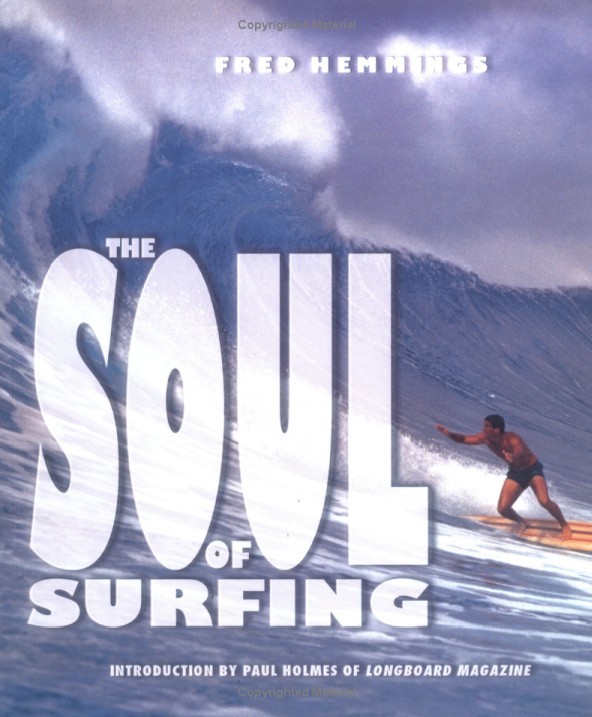
The Soul of Surfing by Fred Hemmings
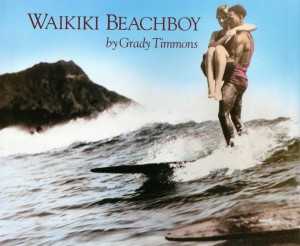
Waikiki Beach Boy by Grady Timmons
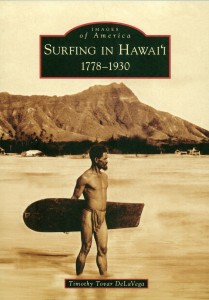
Images in America, Surfing in Hawaii 1778-1930 by Timothy Tovar DeLaVega
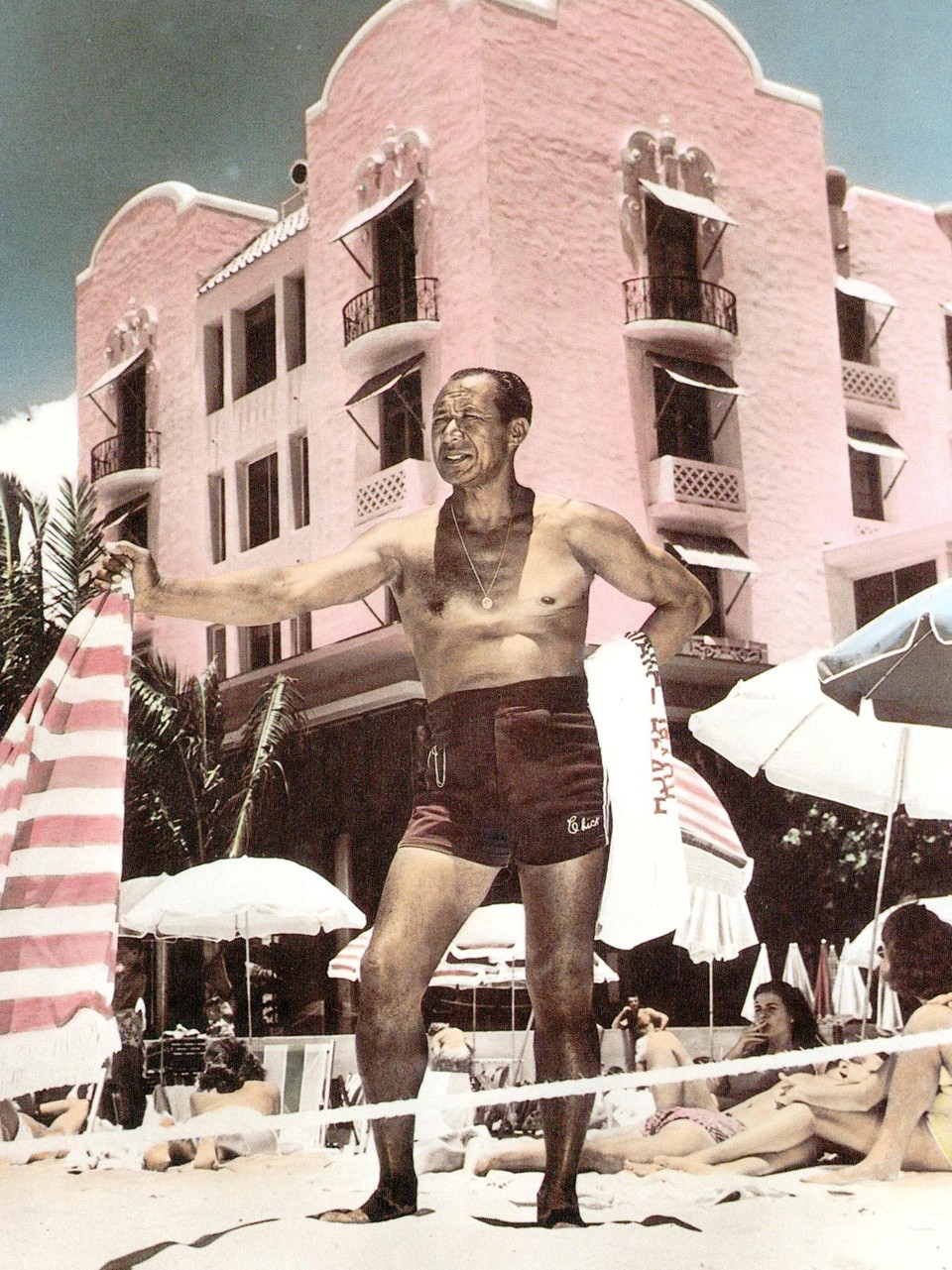
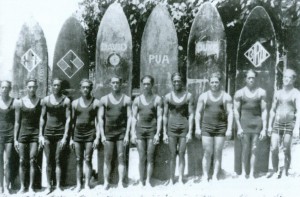
Jimmy and Rabbit taught me how to surf back in 1956! What a legacy!! Propliner travel was like going to a different planet!
Rabbit taught me how to surf at the age of 8 something that changed my life forever I’ll always think about him and my time spent with him I remember not wanting to leave Hawaii rabbit also taught my mom how to serve 24 years earlier at the Royal Hawaiian also he pretty much put me on the path that I see is my identity is a surfer now I now live in San Clemente so I can be next to the waves in the ocean that I still love I think about those days in 1968 all the time I’m so glad to hear that he still alive thanks rabbit period. Matthew Hanna also known as flounder by my beach buddies cuz I had to have a cool nickname like the Beach Boys Oahu